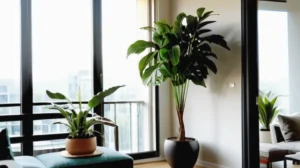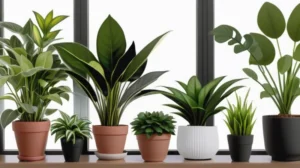Discover the natural solution to improving air quality in your home with these powerful plants that neutralize harmful VOCs.
Introduction to Understanding VOCs
Indoor air quality is a crucial yet often overlooked aspect of our daily lives. As we spend the majority of our time indoors, it’s essential to consider the various factors that can impact the air we breathe, including volatile organic compounds (VOCs).
These invisible chemicals are emitted from a variety of sources such as cleaning products, paints, furniture, and even building materials.
While VOCs play a significant role in the off-gassing process that occurs in indoor environments, understanding how to safeguard against their harmful effects is paramount for maintaining a healthy living space.
Table of Contents
What are VOCs?: Understanding VOCs
- Volatile organic compounds (VOCs) are chemicals that easily vaporize into the air at room temperature.
- They can come from a variety of sources including paints, solvents, cleaning products, and building materials.
- These compounds can have adverse health effects and contribute to air pollution.
Watch on youtube.com: What are Voc’s
Can Indoor Plants Help Reduce VOCs
Indoor plants have been celebrated not just for their aesthetic value but also for their purported ability to improve indoor air quality. Among the pollutants they are believed to combat are volatile organic compounds (VOCs), which are gases emitted by various solids and liquids that may have adverse health effects. Research on the subject provides a mixed but cautiously optimistic view.
VOCs include a variety of chemicals, some of which can cause short- and long-term health issues ranging from eye, nose, and throat irritation to more serious conditions like liver, kidney, or central nervous system damage, and even cancer in some cases. These compounds are emitted by a wide array of products, including paints, varnishes, wax, as well as many cleaning, disinfecting, cosmetic, degreasing, and hobby products. Given how common these items are in homes and offices, finding effective ways to reduce VOC levels is essential for indoor environmental quality.
Plants absorb gases through the pores on their leaves in a process known as phytoremediation. This natural process allows them to take in carbon dioxide and release oxygen through photosynthesis. It’s this same mechanism that suggests they might also absorb VOCs. The idea gained popular attention after a study by NASA in the 1980s suggested that certain houseplants could remove trace levels of toxic vapors from tightly sealed buildings. While this study has been foundational in promoting the use of plants for air purification purposes, it’s worth noting that subsequent research has shown variable results.
Subsequent studies suggest that while plants can absorb some VOCs, the rate at which they do so is highly dependent on specific conditions such as the type of plant, the type of VOC, light levels, humidity levels, and other environmental factors. Moreover, most studies were conducted under controlled laboratory conditions; there’s less evidence about how effectively this translates into real-world settings like homes and offices.
One critical perspective is that while individual plants may not significantly reduce VOC concentrations alone—especially considering the relatively higher volumes of air in living spaces compared to controlled environments—the cumulative effect of multiple plants could be more substantial. Additionally, soil microorganisms play a crucial role in this process; they can break down VOCs at possibly higher rates than the plants themselves.
Can indoor plants help reduce VOCs?
The answer is cautiously positive but nuanced. They likely contribute to lowering concentrations of certain VOCs under specific conditions but should not be relied upon as the sole method for improving indoor air quality.
Other Options when Reducing VOCs in your Home
- Ventilation
Ventilation remains a crucial factor in maintaining a healthy indoor environment. Increasing the flow of outdoor air into a building, when possible, can significantly dilute pollutants, including volatile organic compounds (VOCs), found indoors. - Materials and Chemicals
Furthermore, addressing the sources of VOCs and other pollutants — such as selecting low-emission furniture and building materials, using green cleaning products, and properly storing chemicals — is essential for reducing indoor pollution levels. - Air Purifiers
Additionally, air purifiers equipped with HEPA filters or activated carbon can be effective at capturing or neutralizing some particles and gases in indoor environments; however, their effectiveness varies based on the specific pollutant types and concentrations.
It’s important to choose devices that are appropriately sized for the room where they will be used and to maintain them according to manufacturer recommendations.
Creating cleaner indoor air requires a multifaceted approach that combines source reduction of pollutants with increased ventilation and potential use of purification technology.
While plants may play a role in this comprehensive strategy by improving ambiance and potentially removing certain toxins under specific circumstances, they should not be overestimated in their capability to purify indoor air on their own.
Top Plants for Purifying Indoor Air
Discover the true champions of air purification within our homes: certain plants excel at not only providing a refreshing touch of greenery but also actively eliminating harmful substances lingering in the air. !
- Aloe Vera:
Beyond its soothing properties for sunburns, Aloe Vera acts as a natural air purifier, targeting common VOCs such as formaldehyde and benzene often present in household products and paints. - Spider Plant:
Not only does this aesthetically pleasing plant add a cool vibe to your space, but it also excels at eliminating carbon monoxide, formaldehyde, and xylene. Plus, it’s safe for your furry friends! - Snake Plant (Mother-in-Law’s Tongue):
Sporting distinctive upright leaves, the Snake Plant is a powerhouse in detoxifying indoor air, targeting toxins like formaldehyde, trichloroethylene, and benzene. Its low-maintenance nature makes it perfect for low-light environments. - Peace Lily:
Renowned for its graceful white flowers, the Peace Lily is more than just a pretty face – it’s a formidable opponent against airborne pollutants such as ammonia, benzene, formaldehyde, and trichloroethylene. Just exercise caution around pets, as ingestion can be harmful to them. - Boston Fern:
Admired for its lush greenery, the Boston Fern shines in removing pollutants like formaldehyde and xylene from indoor air. Keep its soil moist and position it in indirect sunlight for optimal performance.
These plants not only enhance your indoor decor but also work tirelessly to maintain a clean and invigorating atmosphere!
| Plant | VOCs Neutralized |
|---|---|
| Aloe Vera | Formaldehyde, Benzene |
| Spider Plant | Carbon Monoxide, Formaldehyde, Benzene, Xylene |
| Lavender | Formaldehyde, Benzene |
| Snake Plant | Formaldehyde, Benzene, Trichloroethylene, Xylene |
| Peace Lily | Ammonia, Formaldehyde, Benzene, Trichloroethylene, Xylene |
Conclusion: Helping Understanding VOCs
FAQs: Everything Else You Want to Know
Got more questions? No problem! We’ll answer some common ones so that we’re all air-quality whizzes.
Can plants really clean the air?
Sure, they look pretty, but do they actually scrub the air like a sponge? We’ll find out!
How many plants do I need for cleaner air?
Is one enough or do we need a jungle? We’ll talk about how to get the balance just right.
Can plants help if someone smokes inside?
We know smoking isn’t good for anyone, but can plants help make things a bit better? Let’s dig into it.





